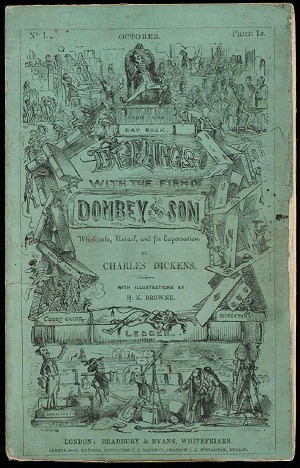 Worcester Polytechnic Institute (WPI) Gordon Library’s Project Boz is using the Internet to help modern readers experience the novels of Dickens in their original, serialized form.
Worcester Polytechnic Institute (WPI) Gordon Library’s Project Boz is using the Internet to help modern readers experience the novels of Dickens in their original, serialized form.
“We wanted to offer everyone the opportunity to encounter these novels as Victorian readers did,” said Kathy Markees, preservation librarian, WPI’s Gordon Library, and co-director of Project Boz with Lora Brueck, assistant director of collections. That doesn’t mean just chopping the text up into chunks. The library is digitizing the pages as searchable PDF images.
“Looking at the high-resolution scans we’ve made of the text, the delightful illustrations (which are not always included in modern printed editions), and the ads from publishers, tailors, apothecaries, and other merchants, is the closest you can come to experiencing these rarely seen serial parts short of holding them in your hands,” Markees said.
Most of the serials originally appeared monthly and cost one shilling per part, adding up to about 20 shillings for the whole novel. Weekly serial installments appeared in magazines which also contained other content and cost about two British pence an issue, adding up to about six shillings for the whole novel.

Joel J Brattin
Said Joel J. Brattin, professor of literature and honorary curator, WPI’s Robert Fellman Dickens Collection, “[Dickens was] a great innovator and entrepreneur who understood the power of serialized fiction and became the master of it. Other writers, including Thackeray, Trollope, and Eliot, jumped on the serialization bandwagon, but only Dickens understood how serial publishing could expand the market for fiction by making literature accessible to people who could not afford to buy whole books. He then expanded the revenue-generating potential of literature by turning it into a vehicle for advertising. Even two centuries after his birth, that seems like a very modern business model.”
(Meanwhile, some Twitter accounts are attempting a modern serialization comeback, with accounts like DickensDaily and Public Domain that send out classic works 140 characters at a time.)
According to Brattin and Markees, the capture work was divided between in-house and a vendor. The vendor did the work on titles that included color, because their more sophisticated equipment was better able to produce high-quality images. In-house capture work was done primarily by the Preservation Librarian with help from student assistants, but the in-house capture system “was difficult to operate consistently and needed frequent intervention by professional staff.” Prior to digitization, conservation treatments on the originals were completed by Markees and the library’s preservation technician.

Kathy Markees
Under Markees’ supervision, paraprofessional staff, student assistants, and volunteer students from UMass Lowell created accurate, corrected OCR of the serial parts so the text can be searched.
The first phase of the project ran from October 2008 to September 2010 and digitized all but three of Dickens’ novels. It was funded by a $30,000 Library Services and Technology Act grant awarded by the Massachusetts Board of Library Commissioners.
The second phase will be to digitize the final three novels, all acquired during the past year. The estimated cost is $12,000, and The Gordon Library is currently seeking funding. When complete, the site will host some 350 serial parts, totaling about 4,000 text pages alone.
The library doesn’t yet have data on how many people are visiting the serials, but expects the site to be included in the university’s Google Analytics coverage soon. In the meantime, “we have gotten some gratifying feedback,” Brattin and Markees said. For now, the site is best viewed on desktop or laptop computers; the serial parts are also readable on iPads, iPhones, and some other mobile devices, but “there appear to be issues with how well the viewer works on some phones.”
Going forward, “the library is exploring how it can make the novels more useful to scholars,” including the possibility of adding variant states of the illustrations and advertisements; making the digitized parts more interactive and user-friendly, such as by compiling the individual PDFs into page-turntable PDFs; and/or adding commentaries and other supporting material. Also for the future, “our recently hired Digital Initiatives Librarian will be looking at the functionality of our digital collections and making recommendations on how to improve access to them” for the blind and print disabled.

